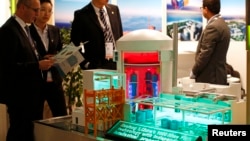The framework nuclear deal between Iran and global powers has opened up new investment possibilities in an economy that has been stunted by international sanctions. Last week, a top Iranian atomic energy official said in addition to Russia, China will also help it build additional nuclear power plants.
China has not commented on the proposal, but Iran says Beijing could help it build at least three nuclear plants in the coastal city Bushehr.
The city is home to Iran’s first nuclear plant, the construction of which began four decades ago.
Germany started work there in the 1970s, but that effort was halted during Iran’s Islamic Revolution. After that, Russia took over in the 1990s, but it was not until 2013 the plant was operating at full capacity.
Oil-rich Iran says it needs nuclear power to meet its energy needs. Uranium fuels nuclear reactors, but can also be used to make nuclear bombs. Iran and world powers are seeking to reach final agreement on a deal by late June.
Chinese expertise
China Center for Energy Economic Research at Xiamen University Director Lin Boqiang says China is well positioned to be a key player in Iran’s nuclear energy program.
Lin says, “China has great strength when it comes to the construction of power plants, given that most of the new plants being built in the world today are in China.” He says “the export of nuclear energy is also something that is essential to the transitioning of the Chinese economy.”
Late last year, the International Atomic Energy Agency for the first time approved a Chinese-designed reactor, giving it the green light for domestic production as well as exports.
Last week, the Chinese government approved the construction of the country’s first third-generation nuclear reactor, the Hualong One.
China is trying to build up its own brand of reactors, says Matthew Cottee, a research analyst with the International Institute for Strategic Studies Non-Proliferation and Disarmament Program.
“The Hualong One is currently being built in China, but it is going to take a while for the international community to have some trust in a new nuclear reactor that has not been built anywhere else,” he said.
Analysts say that first reactor could take six to eight years to build, but China is already exporting the technology abroad.
Chinese media say a power station under development in Karachi, Pakistan could be the first Hualong One built outside China, and Argentina also has agreed on a deal to build one in the South American country. Beijing also has a bilateral deal with Romania and a potential deal with Turkey.
Possible joint ventures
If China carries through on building reactors in Iran, it could partner with another foreign country to mitigate the political risk of such a sensitive project.
“Whether China will be the only country in such a cooperation or whether the Chinese involvement in such nuclear power construction will be in kind of a like a consortium, such as a French company for example, is not yet clear,” said Victor Gao, director of the China National Association of International Studies.
China is already eyeing multi-nation deals to help it break into lucrative foreign markets that could be wary of partnering solely with Beijing.
Analyst Matthew Cottee points to a nuclear power project in Britain that may use Chinese financial backing and French designs.
“If the reactor is built at Hinckley Point in Somerset in the U.K. that will be potentially involving some Chinese funding. But if you look at the memorandum of understanding between the U.K. and China, it kind of paves the way for a potential Chinese indigenous technology to actually be constructed in the U.K.,” said Cottee.
On Tuesday, President Barack Obama proposed a 30-year agreement to cooperate with China on nuclear power. If approved by the U.S. Congress, the deal would allow the transfer of material, reactors, components and technology between the two countries.




